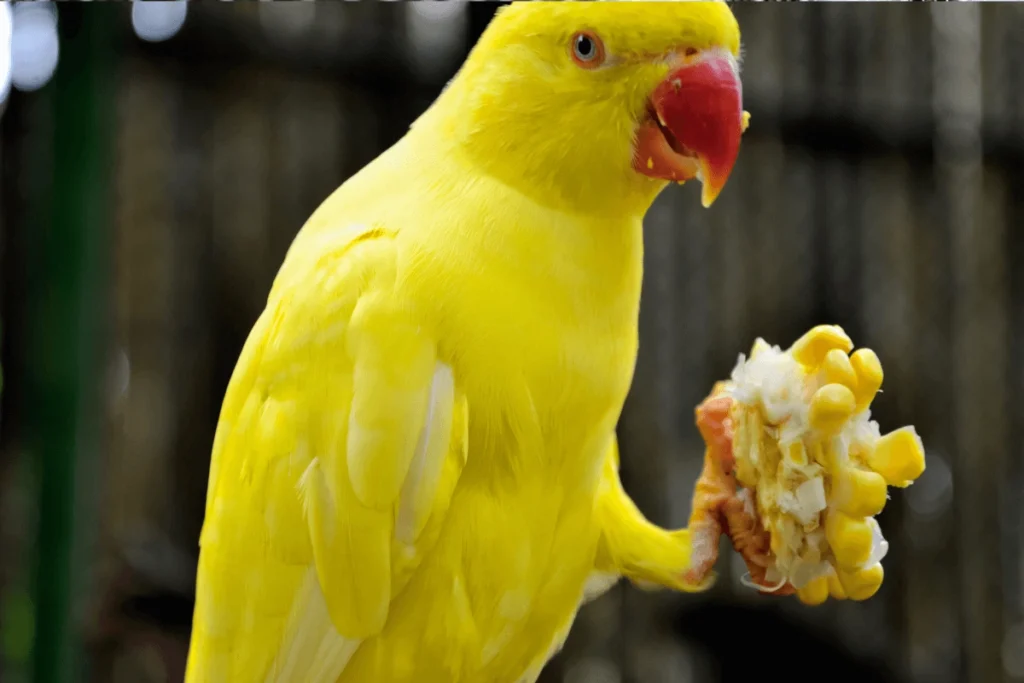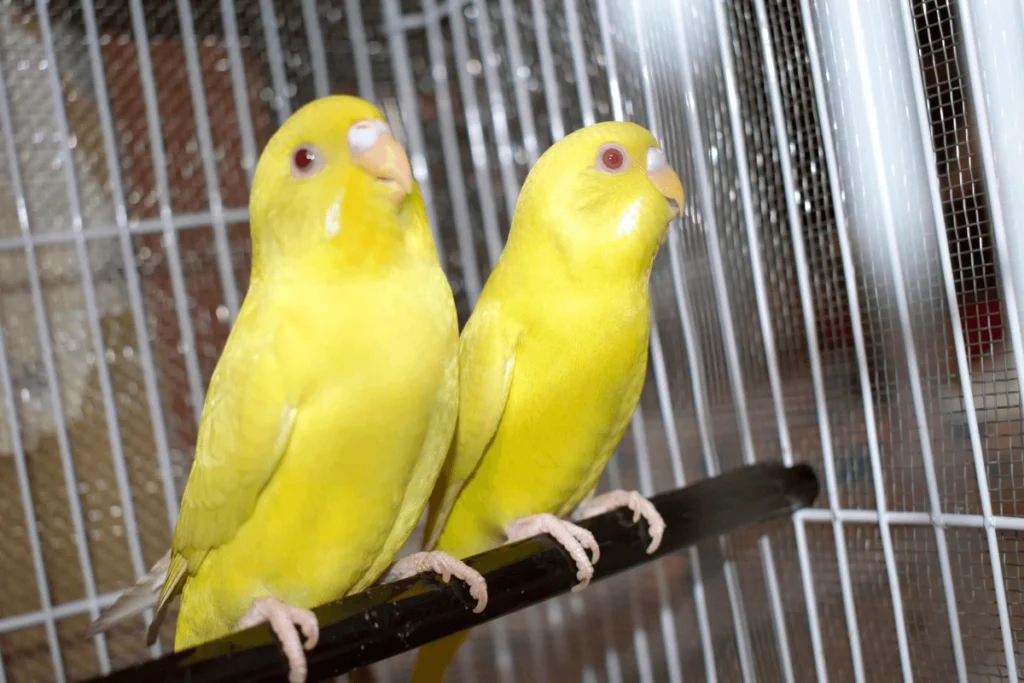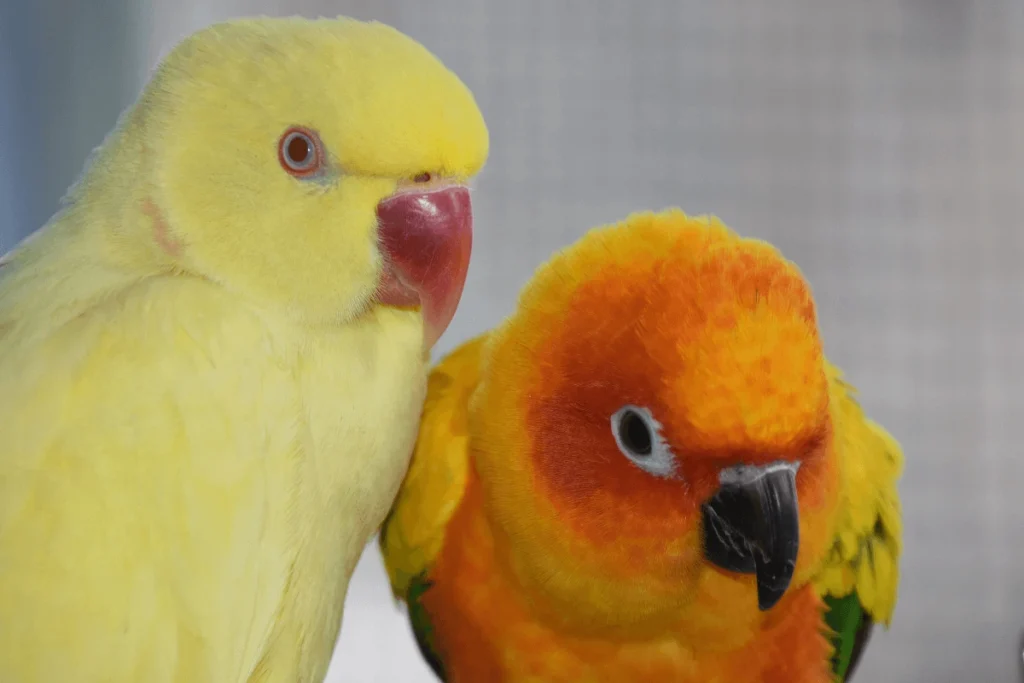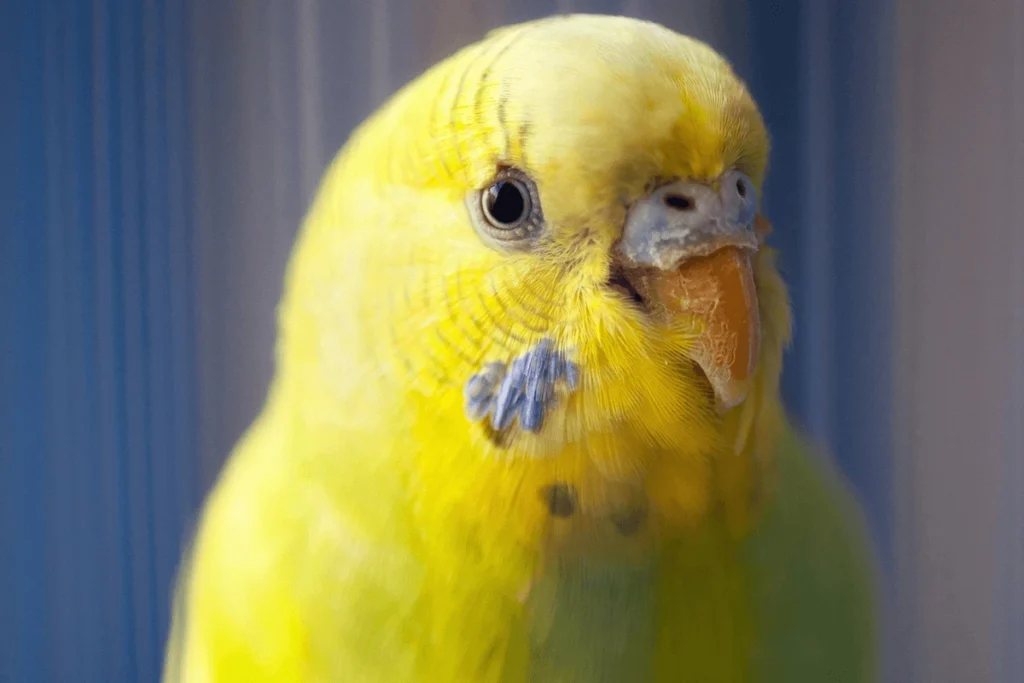The Parrotlet Yellow is a tiny bird with a bold personality, charm, and intelligence. Despite its small size, this vibrant pet is energetic, playful, and affectionate. Owners love its fearless attitude, as it confidently explores its surroundings, interacts with humans, and often behaves like a much larger bird.
Many bird lovers choose the Yellow Parrotlet for its strong bond with its owner. These birds crave companionship and thrive on daily interaction. A well-socialized Parrotlet enjoys perching on shoulders, chirping during conversations, and learning tricks. Their intelligence makes training fun, while their curiosity ensures endless entertainment. Whether hanging upside down, investigating toys, or playfully nibbling fingers, they bring constant joy.
Owning a Parrotlet Yellow requires commitment and proper care. These birds need mental stimulation, a well-balanced diet, and a safe environment to thrive. Without enrichment, they may develop behavioral issues like excessive chewing or territorial behavior. A structured routine, engaging toys, and regular social interaction help them stay happy and well-adjusted.
If you’re considering a Parrotlet Yellow or already own one, understanding their personality, training, and care needs will strengthen your bond. This guide covers everything from diet and cage setup to training and enrichment, showing why this tiny bird makes such a loving and delightful companion.
Understanding the Yellow Parrotlet’s Personality
The Playful and Curious Nature of Parrotlets
The Parrotlet Yellow may be small, but its curiosity knows no bounds. These tiny birds love to explore every inch of their surroundings, using their sharp little beaks and agile feet to interact with objects in their environment. Whether inside their cage or out in the open, they eagerly investigate new toys, climb on perches, and attempt daring jumps with surprising confidence. Their fearless attitude and adventurous spirit make them fascinating to watch.
Because Parrotlet Yellow birds thrive on both mental and physical challenges, owners must provide an enriched environment filled with stimulating activities. Without enough entertainment, these birds may develop destructive behaviors, such as excessive chewing on cage bars, furniture, or even their own feathers. Rotating different types of toys—including chewable wooden blocks, hanging bells, and puzzle feeders—keeps them engaged and prevents boredom-related issues.
While they enjoy social interaction, Parrotlet Yellow birds also display a strong sense of independence. Unlike some pet birds that constantly demand attention, Parrotlets can entertain themselves with toys, foraging activities, or simply observing their surroundings. However, even though they engage in solo play, they still need daily interaction with their owners to maintain their social nature and prevent them from becoming withdrawn or territorial.
Are Yellow Parrotlets Affectionate?
Despite their feisty and playful personalities, Parrotlet Yellow birds form deep emotional bonds with their owners. A well-socialized Parrotlet loves to perch on shoulders, snuggle under hair, or gently nibble on fingers as a sign of affection. Many owners describe them as “big birds in tiny bodies” because they express their love boldly. Some will follow their favorite human around the room, chirp excitedly when their owner comes home, or even try to preen their hair or clothes.
However, their strong bond often comes with an intense sense of loyalty. A Parrotlet Yellow may form a deep attachment to one person and show territorial or jealous behavior if others try to interact. They can become possessive of their favorite human, occasionally lunging or nipping at strangers or even other family members. Stay away from shampoos that have strong smells, colors, or harsh chemicals. Exposing a Parrotlet Yellow to different people from a young age helps them feel comfortable around multiple handlers and reduces the chances of aggressive or overly possessive tendencies.
Socialization and Bonding with a Hand-Tamed Bird
A hand-tamed Parrotlet Yellow adjusts quickly to human interaction, making the bonding process smoother and more enjoyable. These birds recognize their owners and actively seek attention through chirping, climbing onto hands, or playfully nipping. Their strong intelligence and social nature allow them to build trust quickly when handled gently and consistently.
Daily handling strengthens the bond between owner and bird, reinforcing trust and affection. Owners should talk to their Parrotlet Yellow regularly, offer treats as positive reinforcement, and practice step-up training to encourage interaction. Consistent socialization helps shape a Parrotlet’s personality, ensuring that they remain friendly, confident, and well-adjusted. Without proper interaction, they may become shy, fearful, or even aggressive.
Hand-fed and well-socialized Parrotlet Yellow birds develop the sweetest and most affectionate temperaments, making them ideal pets for bird lovers who are willing to dedicate time to bonding and care. When given attention, training, and a stimulating environment, these tiny parrots become some of the most loving and engaging companions a bird enthusiast could ask for.
Proper Care for a Happy and Healthy Parrotlet
Parrotlet Diet and Nutrition: What to Feed Your Bird
Providing the right diet keeps your Parrotlet Yellow healthy, energetic, and happy. These tiny birds need a well-balanced diet that includes high-quality pellets, a nutritious seed mix, fresh vegetables, and occasional fruits. Many first-time owners make the mistake of feeding only seeds, but an all-seed diet lacks essential vitamins and minerals, leading to health problems like obesity and vitamin deficiencies.

A high-quality pellet blend should make up about 60–70% of your Yellow Parrotlet’s diet. Choose a pellet brand specifically formulated for small parrots to ensure proper nutrition. Supplement pellets with a variety of fresh vegetables like carrots, bell peppers, leafy greens, and broccoli. These provide important vitamins that boost immunity and overall health. Fruits such as apples, berries, and mangoes should only be occasional treats since too much sugar can lead to weight gain.
Fresh, clean water must always be available. Change the water daily to prevent bacteria buildup. You should also offer cuttlebone or mineral blocks to support beak health and provide extra calcium, which is especially important for female Parrotlets.
Parrotlet Lifespan and Health Considerations
With proper care, a Parrotlet Yellow can live between 15 and 20 years. However, their lifespan depends on their diet, environment, and overall well-being. Regular veterinary checkups help catch potential health issues early, ensuring your bird stays healthy for as long as possible.
Some common health issues in Yellow Parrotlets include:
- Obesity – Caused by a diet high in seeds and low in activity. Encourage exercise with toys and out-of-cage playtime.
- Vitamin A Deficiency – Leads to respiratory infections and poor feather condition. Prevent this by feeding leafy greens, carrots, and sweet potatoes.
- Beak and Feather Disease – A viral infection that affects feather growth and immune system function. Buy birds from reputable breeders to reduce the risk.
- Respiratory Infections – Exposure to cold drafts, dusty environments, or poor cage hygiene can cause breathing problems. Keep their cage clean and away from direct air conditioning or open windows.
Always monitor your Parrotlet for changes in behavior, appetite, or droppings. If you notice signs of illness, such as fluffed-up feathers, lethargy, or difficulty breathing, visit an avian veterinarian immediately.
Parrotlet Cage Setup: Creating a Safe and Comfortable Home
A well-structured cage setup keeps your Parrotlet Yellow happy and stress-free. Even though they are small, Parrotlets need plenty of space to move, climb, and explore. Choose a cage that is at least 18x18x24 inches, with bar spacing no wider than ½ inch to prevent escape or injury.
Inside the cage, include:
- Perches of different sizes and textures – Natural wood perches help strengthen foot muscles and prevent pressure sores.
- Toys for mental stimulation – Rotate chew toys, bells, and puzzle toys to keep your bird entertained.
- A cozy sleeping area – Add a small fleece tent or a covered corner to help your Parrotlet feel safe at night.
Avoid placing the cage in direct sunlight, near kitchens (due to fumes), or in noisy, high-traffic areas. Position the cage at eye level to help your Parrotlet feel secure and included in family activities.
Maintaining cleanliness is crucial for your Parrotlet’s health. Clean food and water dishes daily, replace cage liners every few days, and deep-clean the entire cage weekly to prevent bacterial growth. A clean, well-equipped cage creates a stress-free environment where your Parrotlet Yellow can thrive.
Training and Enrichment for Your Yellow Parrotlet
Tips for Teaching Basic Commands
Training strengthens the bond between you and your bird while keeping its intelligent mind active. These tiny parrots learn quickly, but they need consistency, patience, and positive reinforcement. Start training as soon as you bring your Parrotlet home to build trust and establish good habits.
Begin with the step-up command, the most essential training cue. Gently place your finger in front of your bird and say “step up” while nudging its lower chest. When your Parrotlet Yellow steps onto your finger, reward it with a small treat, such as a millet spray piece. Repeat this exercise daily to reinforce the behavior.

After mastering step-up, move on to recall training to teach your Parrotlet to fly to you on command. Hold a favorite treat, call your bird’s name, and encourage it to come to your hand. Reward any attempt to move toward you with enthusiastic praise and a treat. Over time, your Parrotlet will recognize its name and eagerly respond when called.
Never use punishment or force during training. If your Parrotlet Yellow seems uninterested or frustrated, take a break and try again later. Short, five-minute training sessions work best, keeping your bird engaged without overwhelming it.
Best Toys for Parrotlets: Keeping Your Bird Entertained
Toys play a critical role in keeping your Parrotlet Yellow mentally and physically stimulated. Without enough enrichment, these birds can develop behavioral problems like excessive screaming, feather plucking, or aggression. Having different toys helps keep them busy and stops them from getting bored.
Some of the best toys for Parrotlet Yellow include:
- Puzzle Toys – Small treat-dispensing toys challenge your bird’s intelligence and encourage problem-solving skills.
- Chew Toys – Natural wood, soft balsa, or shreddable paper toys satisfy their need to chew and help maintain beak health.
- Swings and Perches – Adding a swing or a rope perch gives your Parrotlet extra exercise while making its cage more fun.
- Foraging Toys – Hiding treats inside a foraging box or stuffed paper roll mimics natural behaviors and provides hours of entertainment.
Rotate toys regularly to keep your Parrotlet Yellow engaged. Introducing a new toy every couple of weeks prevents boredom and encourages exploration.
Out-of-Cage Playtime: Encouraging Exercise and Interaction
Letting your Parrotlet Yellow explore outside the cage every day improves its physical and mental well-being. These birds love to stretch their wings, climb on their owner’s shoulders, and investigate their surroundings. Provide a safe, bird-proofed area free from toxic plants, open windows, or other pets.
Set up a play gym with ladders, ropes, and small hanging toys to create an engaging environment. Encourage flying by gently tossing a soft object (like a crumpled tissue) to prompt your bird to chase after it. This type of exercise builds confidence and strengthens muscles.
During out-of-cage time, interact with your Parrotlet Yellow by playing games, offering treats, or practicing training exercises. These activities reinforce your bond and prevent loneliness. Regular socialization makes your Parrotlet more affectionate, reducing the chances of aggressive or fearful behavior.
Choosing the Right Yellow Parrotlet for Your Home
Pacific Parrotlet vs. Celestial Parrotlet: Which One is Right for You?
When choosing a Parrotlet Yellow, you may come across different species within the Forpus genus. The most common pet Parrotlets are the Pacific Parrotlet (Forpus coelestis) and the Celestial Parrotlet (another name for the Pacific Parrotlet). Some breeders also offer other species, such as the Mexican Parrotlet (Forpus cyanopygius) or Green-Rumped Parrotlet (Forpus passerinus), but these are less common in the pet trade.
The Pacific Parrotlet has a bold, playful personality and forms strong bonds with its owner. This species thrives on attention and socialization but may develop possessive tendencies if not handled regularly. If you want a Parrotlet that actively engages with you, learns tricks, and enjoys training, the Pacific Parrotlet is a great choice.
On the other hand, if you prefer a slightly more independent bird, consider other Parrotlet species. The Green-Rumped Parrotlet, for example, tends to be gentler and less assertive, making it a good option for beginners. Regardless of the species you choose, all Parrotlet Yellow birds share the same small size, intelligence, and energetic nature.

Understanding Parrotlet Mutations: The Beauty of Color Variations
In the wild, most Parrotlets have green plumage with subtle blue markings, but selective breeding has created stunning color mutations. The Yellow Parrotlet, also known as the Lutino Parrotlet, features a bright yellow body with striking red eyes. This rare mutation makes it one of the most visually appealing options for bird enthusiasts.
Besides Lutino, breeders have also developed other fascinating Parrotlet mutations, such as:
- Albino Parrotlet – Pure white with red eyes, created by combining the Lutino and Blue mutations.
- Blue Parrotlet – A beautiful, soft blue variation without any green pigmentation.
- Turquoise Parrotlet – A mix between blue and green, giving the bird a unique aquamarine shade.
If you want a Parrotlet Yellow, make sure to find a reputable breeder specializing in color mutations. Healthy Lutino Parrotlets should have bright plumage, clear eyes, and active behavior. Since mutation Parrotlets can be more delicate than their wild-colored counterparts, provide a proper diet, regular exercise, and veterinary care to ensure a long, healthy life.
Hand-Tamed vs. Untamed Birds: What to Expect
Choosing between a hand-tamed Parrotlet Yellow and an untamed bird makes a huge difference in your experience as a bird owner. A hand-tamed bird has already interacted with humans from a young age, making it friendly, confident, and comfortable with handling. These Parrotlets step onto fingers, accept treats, and enjoy socializing with their owners. If you want a bird that easily bonds with you, a hand-tamed Parrotlet Yellow is the best choice.
In contrast, untamed Parrotlets have little or no human interaction. These birds tend to be more nervous, skittish, and difficult to train. If you choose an untamed Parrotlet Yellow, prepare to spend weeks or even months building trust. Patience, positive reinforcement, and consistent handling will help your bird overcome fear and become more social over time.
To ensure you bring home a healthy and well-adjusted Parrotlet Yellow, ask the breeder or pet store about the bird’s background. A good breeder will handle young Parrotlets daily and expose them to different people and environments. Look for a bird that shows curiosity, interacts with its surroundings, and responds to human presence.
Conclusion
Owning a Parrotlet Yellow is a rewarding experience for bird lovers who want a tiny companion with a big personality. These energetic birds bring joy, laughter, and affection into their owners’ lives. Their intelligence allows them to learn tricks, their playful nature keeps them active, and their strong bonds with humans make them excellent pets for dedicated owners. However, they require proper care, daily interaction, and mental stimulation to stay happy and healthy.

Before bringing a Parrotlet Yellow home, consider the level of commitment involved. These birds live up to 20 years, meaning they need long-term care, a well-balanced diet, a safe living environment, and regular visits to an avian veterinarian. If you provide the right care and attention, your Parrotlet Yellow will thrive and reward you with years of companionship.
If you want a bird that enjoys human interaction, learns quickly, and thrives on enrichment, a Parrotlet Yellow is a fantastic choice. Their vibrant color, bold personality, and affectionate nature make them one of the most charming small pet birds available. Whether you choose a hand-tamed Lutino Parrotlet or train an untamed bird to trust you, the bond you develop will be truly special.
Are you ready to welcome a Parrotlet Yellow into your life? If so, start by finding a reputable breeder or rescue, setting up a proper cage, and preparing for a lifetime of love, fun, and companionship with this tiny but incredible bird.
Read More About The Amazonian Parrotlet Here!
Learn About the Top 10 Small Parrots for New Owners Here.
Discover The Purple Parrot Birds From Here.
Read About Other Pets and breeds From HERE!
Find Out the Best stuff for your Pet On Pet MD Official.
